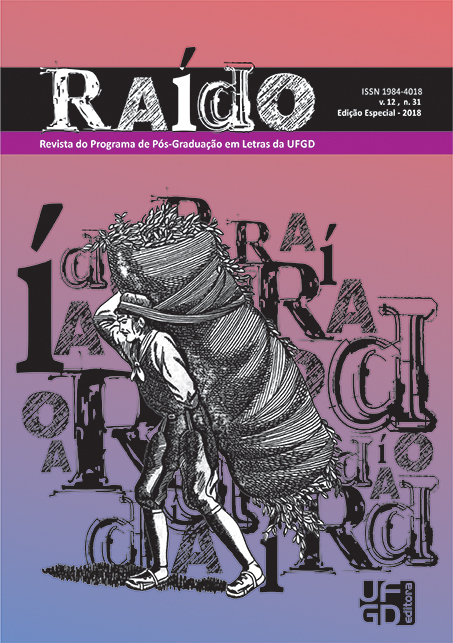Buster Keaton: a post-human body?
DOI:
https://doi.org/10.30612/raido.v12i31.7810Keywords:
Buster Keaton. Body. Post-human.Abstract
In this paper, I discuss the possibility of relating the corporal manifestations of comic actor/director Buster Keaton in his films with the concept of post-human, mainly its vision of new corporal configurations. Some specific characteristics of this body manifestation of Buster could indicate this approach: a kind of relation with its environment, in a kind of symbiosis with objects, animals and machines; a dilution of identities and boundaries, in a constant state of “being-between”; and an overcoming of the limitations of the human. The discussion is organized in three parts. In the first place, I introduce the cinema of Buster Keaton, with the purpose of pointing out some characteristics which are central for the analysis that is made, mainly with respect to the corporal manifestation of his character. Following are some discussions about the post-human, both as a field of research and as a term that indicates new experiences and configurations of the human in the contemporary world. Finally, some readings on Keaton’s work are undertaken in the dialogue with the debates on post-humanity.
Downloads
References
AUMONT, J.; MARIE, M. Dicionário teórico e crítico de cinema. Tradução de Heloísa Araújo Ribeiro. 5. ed. Campinas: Papirus, 2012, p.37.
BAECQUE, A.. Telas: o corpo no cinema. In: COURTINE, J. J. (org.). História do corpo: 3. As mutações do olhar: O século XX. Tradução de Ephraim F. Alves. 2. ed. Petrópolis: Vozes, 2008, pp. 481-507.
CLAYTON, A. The body i Hollywood Slapstick. Carolina do Norte: McFarland & Company, 2007.
COUSINS, M. História do cinema: dos clássicos mudos ao cinema moderno. Tradução de Cecília Camargo Bartalotti. São Paulo: Martins Fontes, 2013.
FELINTO, E.; SANTAELLA, L. O explorador de abismos: Vilém Flusser e o pós-humanismo. São Paulo: Paulus, 2012.
HUNTER, R. A comédia muda. In: KEMP, P. (Org.). Tudo sobre cinema. Tradução de Fabiano Morais et al. Rio de Janeiro: Sextante, 2011, pp. 62-63.
JULLIER, L.; MARIE, M. Lendo as imagens do cinema. Tradução de Magda Lopes. São Paulo: Editora Senac São Paulo, 2009.
MICHAUD, Y. Visualizações: o corpo e as artes visuais. In: COURTINE, J. J. (org.). História do corpo: 3. As mutações do olhar: O século XX. Tradução de Ephraim F. Alves. 2. ed. Petrópolis: Vozes, 2008, pp. 541-565.
SANTAELLA, L. Culturas e artes do pós-humano: da cultura das mídias à cibernética. 2 ed. São Paulo: Paulus, 2004.
SMITH, I. H. A general. In: KEMP, P. (Org.). Tudo sobre cinema. Tradução de Fabiano Morais et al. Rio de Janeiro: Sextante, 2011, pp. 66-67.
TESSÉ, J.-P.. Le burlesque. Paris: Cahiers du cinéma, 2007.
Downloads
Published
How to Cite
Issue
Section
License
Os autores devem aceitar as normas de publicação ao submeterem a revista, bem como, concordam com os seguintes termos:
(a) O Conselho Editorial se reserva ao direito de efetuar, nos originais, alterações da Língua portuguesa para se manter o padrão culto da língua, respeitando, porém, o estilo dos autores.
(b) Autores mantém os direitos autorais e concedem à revista o direito de primeira publicação, com o trabalho simultaneamente licenciado sob a Atribuição-NãoComercial-CompartilhaIgual 3.0 Brasil (CC BY-NC-SA 3.0 BR) que permite: Compartilhar — copiar e redistribuir o material em qualquer suporte ou formato e Adaptar — remixar, transformar, e criar a partir do material. A CC BY-NC-SA 3.0 BR considera os termos seguintes:
- Atribuição — Você deve dar o crédito apropriado, prover um link para a licença e indicar se mudanças foram feitas. Você deve fazê-lo em qualquer circunstância razoável, mas de nenhuma maneira que sugira que o licenciante apoia você ou o seu uso.
- NãoComercial — Você não pode usar o material para fins comerciais.
- CompartilhaIgual — Se você remixar, transformar, ou criar a partir do material, tem de distribuir as suas contribuições sob a mesma licença que o original.
- Sem restrições adicionais — Você não pode aplicar termos jurídicos ou medidas de caráter tecnológico que restrinjam legalmente outros de fazerem algo que a licença permita.



